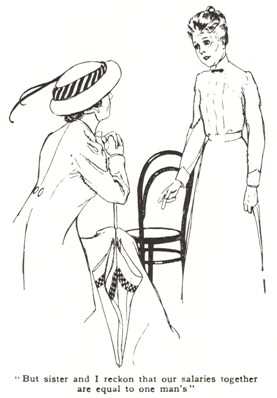
The Glass Ceiling
“We are a band of sisters we must have sympathy in each others woes.”
-An Operative in Voice of Industry
January 8, 1847
“We war with oppression in every form.”
-Sarah G. Bagley in Voice of Industry
May 15, 1846

Various women's movements largely contributed to a woman's ability to attain a part time or full time job that allowed her to escape the domestic confinement she was often subject to. Women were very pleased with the idea that they were able to earn salaries of their own and reduce their monetary dependence on men. As a result, it was only after the women's labor movement was in full swing, that they realized their progress in the workplace could only go so far . As women slowly began to incorporate themselves into the workforce of Chicago, they were soon to find out that the term “working women” had its limits unlike their idealistic dreams that initially brought them to the city. Higher authority, that is to say men and society, controlled almost every aspect of the working woman. For example, women who wanted to work in professionalized sectors often found themselves confined to jobs that required a motherly figure or some sort of caretaker (9). “Even as late as 1933, the requisites of personality, poise, appearance, and responsiveness would be listed, reflecting characteristics perceived to be female” (9). There were invisible boundaries that confined the women to a small sector of the workplace, while giving them the illusion that they were free and empowered.
Furthermore, since it was uncommon to have women in the workplace before the early twentieth century, these women entered the world of employment without much or any prior experience to ensure them with equal and fair treatment. Discussion of salaries often did not include the working women themselves (4). Since it was assumed that women had not been around long enough to gage an appropriate salary for a specific task, they were often given salaries high enough to attract women to the workplace, but low enough to employ female workers who required less salary than men (4). In Sister Carrie, a good example of this situation is at the beginning of the book when Carrie sets out on her mission to find employment. She soon finds out that after paying her dues at her sister's house, she will come home only with a backache and a few cents in her pocket (4). The city was not all she dreamed that it would be because the glass ceiling above women in the workforce hindered her progress. It was only until a few bold women realized that there was power in numbers that they were able to shatter the glass and attain the true freedom that every worker is entitled to.
“Her idea of work had been so entirely different (4)."